zeroplus
Designed for Site #2 in Abu Dhabi, between Saadiyat Island and Yas Island.
zeroplus (Joshua Brevoort, Lisa Chun, and Ian Campbell) with Jennifer Dixon
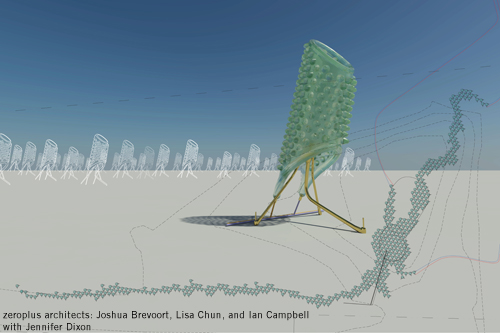
Design Submission for the 2010 Land Art Generator Initiative Design Competition
Artist’s descriptive text:
In the Arabic language, there are at least ten names for water based upon salinity and potability. Beginning with ujaj, which is the bitterest and most saline water, and ending with zulal, clear, sweet, cool water. DEWelectric encompasses the principle of the bitterest of water to the sweetest.
Water has always been regarded as a precious resource in the Arab world and water conservation is well-documented in Islamic teaching.
Fresh water, a scarce resource in the UAE, is precious. It sustains all life, is nourishing, cleansing, regenerative, purifying, and rich in symbolic meaning.
Water scarcity is one of the most pressing problems confronting humankind in the new century. The natural water resources of the UAE will decrease by 16 per cent in the next decade, requiring the second-largest build-up of desalination plants in the world. Demand is soaring, with the country expected to increase desalination capacity by 76 per cent by 2016, to 14.1 million cubic liters a day.
Desalination plants, while solving some problems, create others. Desalination is expensive, energy intensive and emits greenhouse gases. Waste from the process is highly concentrated brine that can contain biocides, high concentrations of metal, and chlorine. Adequate and safe disposal of the concentrated brine presents a significant environmental challenge. In addition, large marine organisms, such as adult fish, invertebrates, birds, and even mammals, are killed on the intake screen. Decomposition of these organisms can reduce the oxygen content of the water near the discharge point, creating additional stress on the marine environment.
Our team chose Site #2 to develop a significant series of closed loop power generators by taking advantage of the coastal conditions provided on site. DEWelectric combines beauty, simplicity, and function into responsible energy production through biomimicry while demonstrating the potential for generating fresh water and clean, efficient electrical power.
The artwork consists of three components: an array of pneumatic condensers, a channeled walkway, and a shaded community gathering space that celebrates the vitality of water.
Pneumatic Condenser
The Namib Desert beetle (genus Stenocara) survives in the harsh environment of the Namib Desert where only a half-inch of rain falls annually. In response to the arid environment, the beetle has developed a unique water collection mechanism. A series of small bumps on the surface of its wings enable the beetle to collect water from fog that forms in the early morning and blows across the desert floor. When the beetle positions its body at 45 degrees the fog collects on its back and runs down the wings to its mouth, supplying the animal with water necessary for its survival.
Mimicking the Namib Beetle, each ‘water stalk’ condenser in DEWelectric is designed to draw water out of the air while simultaneously generating electricity and providing both fresh water and power to the region. Each condenser is constructed from a pneumatic tube that circulates fluid cooled by seawater. When the warm moist air reaches the surface of the tubes, water vapor condenses on the colder surface of the tower that is textured much like the beetle’s hydrophilic shell. The coolant is then returned to the sea in a closed loop system to be re-chilled by the sea. The delta in temperature around the chilled water stock towers creates a negative pressure that draws air down the column spinning a 7.5 kilowatt wind turbine that generates electricity to feed the grid as well as the pumps that draw the water from the sea to the condensers.
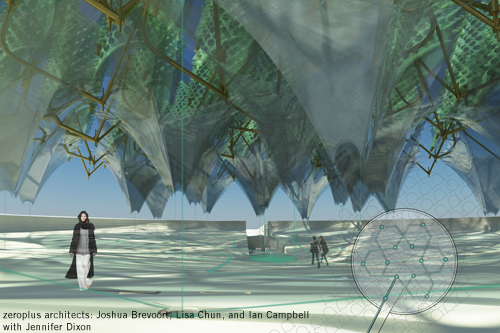
A total of 475 proposed towers are distributed in a semi-random array that extends throughout the site in a pattern that resembles the natural flow of water to or from a single source. Each tower, approximately 4.5 meters in diameter and 16 meters high will generate 180 kilowatt hours per day of electricity and 485 liters of water per day. This passive method of water collection also reduces consumption from the grid by a total of 3,217,600 kilowatts of power per year, a conservative estimate for even the most efficient and state of the art desalinization plant. This is output scalable depending on desired performance criteria. Supported on tripod legs that interlock together to add an organic quality to the repetitive tower elements and supports, they tread lightly on the land in order to reduce its impact to the site. These support legs become a tensegrity structural system enhanced by a protective shade covering device that collects and funnels water over the bowl shaped ‘rain space’ gathering area. The cooling effects of the tower clusters and shading devices creates comfortable places and subtle climatic shifts for people to gather and explore the passive systems of Yaz Island’s DEWelectric that benefits the entire region.
The Approach
From the road, cars come upon the vast blue-green field of ‘water stalk’ condenser towers. The public is invited to park their car and approach the site via a long concrete walkway sliced into the slightly inclined grade. Inspired by the ancient system of water channels know as aflaj (sing. falaj), a continuous conduit of water runs alongside the path and leads into the immense hall of water, or RainSpace. As one nears the interior, the ambient temperature drops and the water level rises. The channel of flowing water serves as an indicator of water production and provides a circulatory pathway to the entrance of the communal gathering space.
The RainSpace
RainSpace is an all-encompassing experience of water. As one enters the shaded water chamber, the effect of the overhead condensers and the canopy of collectors provides a significantly cooler environment than the surrounding desert setting. RainSpace provides a communal gathering place where viewers experience a continuously live event of ‘raining’ water. Water falls from above into a ‘carpet’ of inlaid channels that create an overall pattern inspired by the natural world. Referencing the inherent beauty of Islamic patterns, the continuous flow of water both above and below expresses infinity, unity, harmony and balance. Similarly, at first glance the process may appear extremely complex, yet the simple elegance of the system is revealed and immediately understandable to the viewer. The ordered repetition of the overall system, both above and below symbolizes a well-balanced whole. RainSpace creates a visceral and sensory experience that celebrates and honors the value of water in our lives.
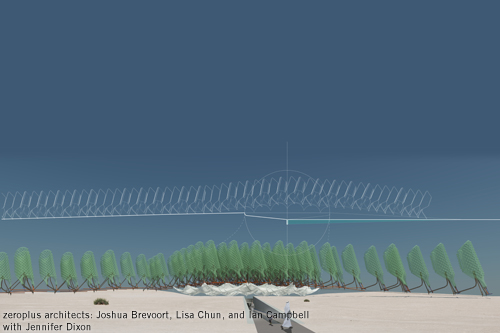
Total DEWelectric Power and Water output generation
• Electricity: 180 kWh per day per tower or 85,500 kWh per day total (before seawater pump correction)
• Water: 1,354 liters per day per tower or 643,520 Liters per day total
• Water production is equivalent to 3,217,600 kWh reduced energy consumption from the grid (based on a conservative estimate for state of the art desalinization water generation)
Environmental Impact Statement
While the DEWelectric condensers generate power to the grid, the greatest benefit of the art is the collection of pure water, which is precious to the UAE. While water is currently supplied to the area from the Umm Al Nar desalinization plant, production in this manner consumes a tremendous amount of power in the process resulting in the emission of greenhouse gasses and creates a toxic saline briny sludge by-product that must be disposed of in a manner that greatly impacts the balance of natural systems. DEWelectric eliminates both of these substantial negative impacts through the creation of a passive system that produces zero carbon emissions.
The proposal requires a cooling loop at the floor of the seabed nested in the existing dredged areas which would minimize disturbance to existing marine ecosystem and also provide lower and more stable temperatures for cooling. This requires extending beyond site boundaries; alternatively, it is possible that the chilling loop can run underground with similar performance standards. In this scenario, the site would require additional excavation beyond what is already required for trenching a water distribution (system modeled after ancient falaj system) as well as to carve out a ceremonial gathering space into the raised contours of the site. The structural system for the towers are intended to touch down lightly with minimal impact upon the landscape and arranged to leave much of the site untouched. The cooling effect of the towers will create small microclimatic temperature zones as the wind moves through the site creating comfortable inhabitable outdoor places for people to occupy during even the hottest times of the year.

In addition, the entire installation provides a safe environment for visitors to explore and interact in and amongst the ‘pneumatic condensors’ providing a means for people to learn about the rich possibilities of passive water and energy harvesting in a direct and experiential manner and gather around the celebration of water and clean power.
Related Posts
2 Comments
Add comment Cancel reply
This site uses Akismet to reduce spam. Learn how your comment data is processed.

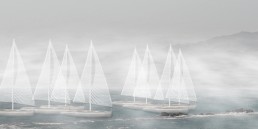
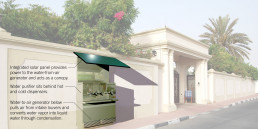
[…] link: http://landartgenerator.org/blagi/archives/976/trackback […]
[…] direct and experiential manner and gather around the celebration of water and clean power. Source: The Land Art Generator Initiative Reageer […]